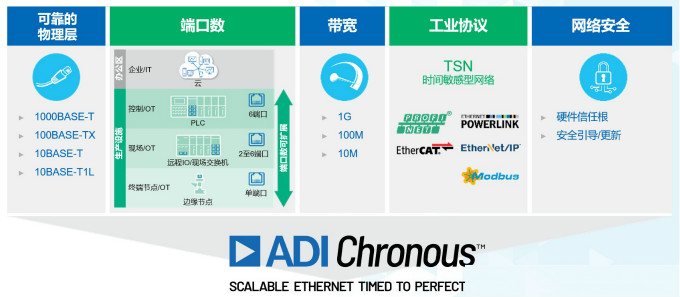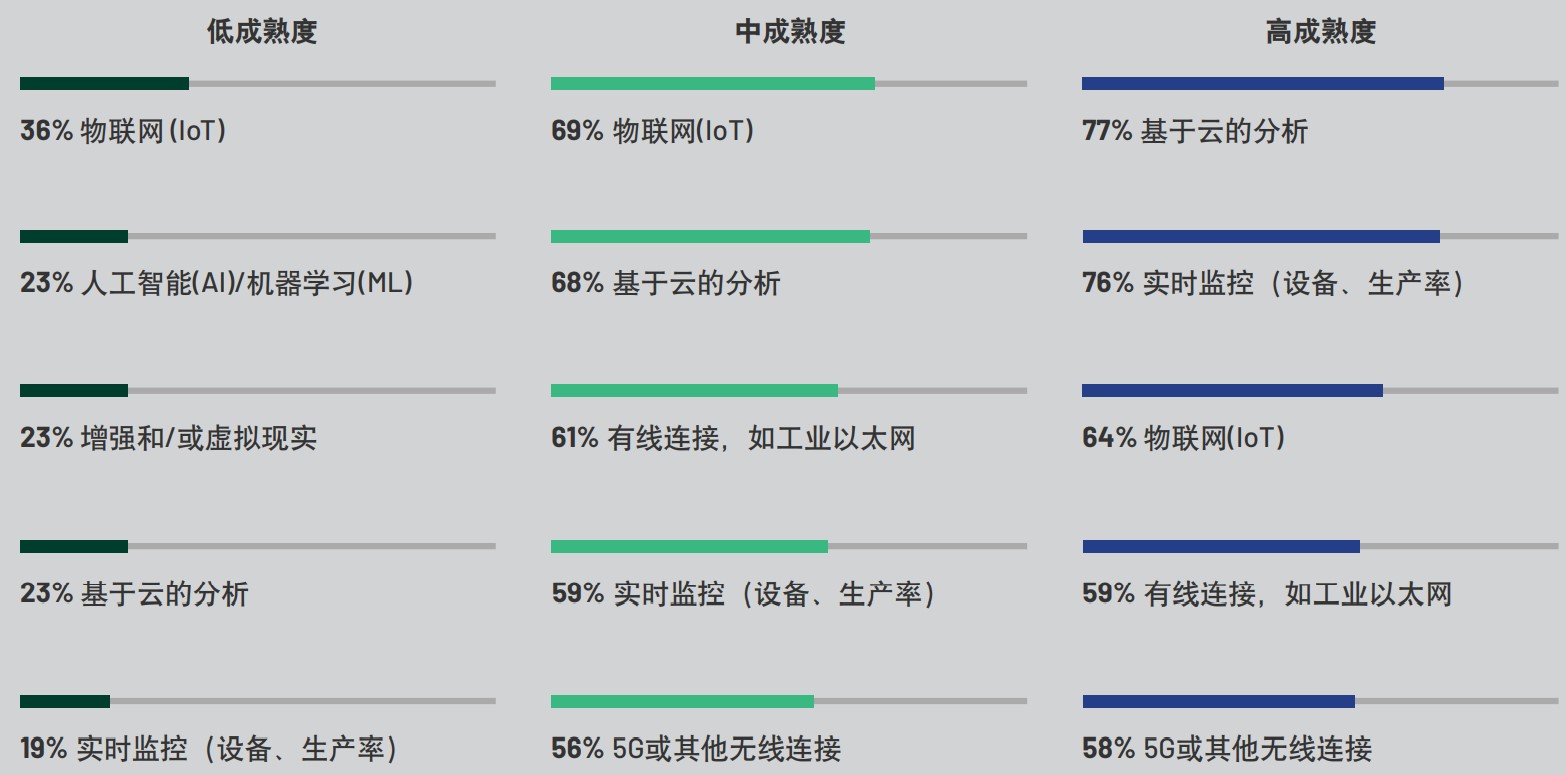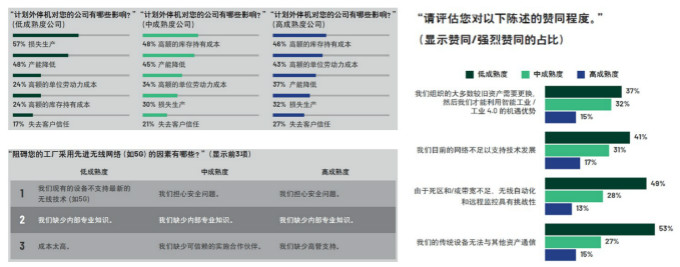[Guide]Earlier this year, the Ministry of Industry and Information Technology issued the “Industrial Internet Innovation and Development Action Plan (2021-2023)” to deploy the key work content of the industrial Internet in the next three years, including: implementation of the network system strong foundation action, and promotion of the industrial Internet network The interconnection project promotes the deep integration of IT and OT networks; the implementation of the platform system expansion action, promotes the industrial Internet platform system upgrade project, and promotes the number of industrial equipment and business systems on the cloud to double the number of platforms in 2020; etc. The action plan fully reflects the general trend of the current industrial digital transformation. At the 9th EEVIA Annual China ICT Media Forum and 2021 Industry and Technology Outlook Symposium, ADI released its first offline thought leadership white paper “Insights on Digital Transformation of Industry 4.0: None The key findings of “Seam Connection Promotes Industrial Innovation” also reflect this trend.
In this white paper, ADI commissioned Forrester Consulting to evaluate the status quo of industrial modernization. It surveyed 312 senior manufacturing leaders who are responsible for formulating industrial connectivity strategies within their respective organizations. “The current competitive advantage of enterprises comes from the ability to reliably transform industrial data into reliable and actionable insights, and connectivity is the basis for driving innovative insights. For those manufacturers who develop both security and network reliability strategies, they are facing A bright future.” Cai Zhenyu, director of ADI China’s industrial marketing, pointed out when interpreting the white paper at the seminar, “We hope to evaluate the current state of industrial connectivity through investigations, and then see how to use products and technologies to help these customers accelerate their digital transformation.”
Cai Zhenyu, Director of Industrial Marketing, ADI China
To build a “flat” factory of the future, the interconnection of the manufacturing industry requires technology and network upgrades
“The core point of the industrial digital transformation path is to first obtain a sufficient amount of data. The prerequisite is a large number of connections. Connection is the first and most important task. At this stage, improving the quality and capabilities of connections is crucial. .” Cai Zhenyu said. Advanced and high-level industrial connections can ensure that a large amount of industrial data is transformed into insight and determination, and ultimately achieve better business output and a fundamental guarantee for industry disruption. With the blessing of a new generation of industrial connections, assets and technologies will form an efficient, flexible and flexible ecosystem through the connection, which can easily adapt to unique manufacturing needs and take into account future trends.
How does your company prioritize the following technology investments?
The survey data shows that due to the objective differences in the existing foundations, companies with different maturity levels (the survey respondents are divided into low, medium, and high according to the maturity of the digital transformation of the enterprises in the survey) have different requirements for the future of the industrial Internet. Priorities for investment in emerging technologies are prioritized. Taking IIoT technology as an example, 85% of high-maturity companies said that IIoT technology currently supports many factory floors, compared to 66% of medium-mature companies and only 17% of low-maturity companies. For low-maturity companies, IIoT is the primary focus of technology investment, which means that their development directions are similar, but the progress is relatively slow.
When manufacturers try to connect more assets, they obviously want to connect through a hybrid wired/wireless network. For most medium and high-maturity companies, investing in wired (such as industrial Ethernet) and wireless (such as 5G) connections is a key priority. Even the most mature interviewees admitted that there is still a lot of work to be done. In fact, compared with competitors, only 39% of high-maturity companies believe they have done a very good job of achieving digital priority. Among medium-maturity and low-maturity companies, this ratio is even lower. In essence, the manufacturing industry is an asset-intensive industry, and the realization of digital priority requires a secure and reliable network to connect physical and digital assets.
“On this basis, it can be foreseen how the factory will expand from the “vertical” structure under the traditional independent network to the future “planar” structure: a higher level of information technology (IT) or corporate infrastructure will be linked to the control network of the plant (OT) integration; various existing networks or production units in the factory will coexist and support interactive operations; seamless and secure connections will be realized in the entire process environment, from the process terminal to the enterprise cloud. Under this new structure The physical interface and protocol of the company will be unified into a’one node’, through the standardized TSN (Time Sensitive Network) and IT interface, and connect and communicate with upstream data.” Cai Zhenyu pointed out.
The factory of the future under the “flat vertical structure”
Identify the key crux of the landing, ADI solutions help industrial digital transformation
Despite the different needs, the survey shows that the main pain points of the modernization of the existing infrastructure of all companies are converging: unplanned downtime is costly; traditional systems and networks cannot support modern digital services; lack of expertise slows down the speed of network improvement. How to prescribe the right medicine? Cai Zhenyu gave a suggestion: “Choose a connection strategic partner. For companies that often struggle in the industrial field, what they lack is the corresponding IT or connection experience. ADI hopes to become a companion in the digital journey of China’s industry.” How to help Companies of different maturity levels build the factory of the future? Cai Zhenyu summarized two major directions: achieving safe, flexible, and reliable connections; accelerating the landing of digital applications.
Survey data-three major pain points of the difficult process of modernization of existing infrastructure
Focus on the value proposition of industrial Ethernet and realize safe and unified interconnection. Various Ethernet protocols and even physical interfaces in the current industrial environment are not uniform. The confusion of the interface protocol has led to the relative independence of the equipment end, control end, and application end of the traditional industrial system design, and there is no way to connect to the real network. “In this regard, ADI’s scalable and secure deterministic Ethernet solution can provide seamless and secure connection technology from the edge to the cloud, which can connect the corresponding products of the entire factory, from process control to interconnected motion.” Cai Zhenyu Continue to share, “A stronger chip core can connect the corresponding products of the entire factory to achieve the interconnection of all things; higher bandwidth can bring better ease of use, help to help the integration of IT and OT, and improve Flexible production efficiency is also a good carrier for TSN.”

ADI provides seamless and secure connection technology from edge to cloud
In order to realize industrial IoT applications, it is necessary to support various common network topologies, such as PROFINET, EtherNet/IP®, EtherCAT®, POWERLINK® and other common industrial Ethernet protocols, as well as linear and ring topologies and star topologies, created by ADI The fido5000 series products are real-time Ethernet, multi-protocol (REM) switching chips with two Ethernet ports, and are programmable IEEE 802.3 10 Mbps/100 Mbps Ethernet Internet Protocol Version 6 (IPv6) and Internet Protocol Version 4 (IPv4) ) Switch. In addition, ADI’s new generation of three-port ADIN1300 is a network chip that supports TSN. It uses twisted-pair cables for transceivers and uses standard xMII interfaces. It can be connected to any processor. It has ultra-low latency and ultra-low power consumption. Used in industrial scenarios such as rail transit; and software configurable input/output (I/O) product series (AD74412R and AD74413R) that can help manufacturers and industrial operators improve the flexibility of control systems.
In addition, 5G is accelerating its deployment in various industries and will surely bring new changes to industrial connections. The three major characteristics of 5G-high transmission rate, massive connections, and low latency (URLLC) make 5G+ industrial sites a possible breakthrough point for 5G in the industrial field. “The combination of 5G and TSN will be the direction of the development of the Industrial Internet and promote the innovation of seamless industrial connection.” Cai Zhenyu pointed out.
Improve the digital level of the production line, starting with equipment condition monitoring. Unplanned shutdowns have become the main pain points of enterprises as shown by the survey data. In recent years, more and more equipment condition monitoring (CBM, Condition Based Monitoring) has been used by industrial enterprises as the main means to avoid unexpected equipment shutdown accidents. The vibration status of equipment is collected and analyzed. Improve equipment performance, production efficiency and added value.
In order to realize equipment condition monitoring, ADI has introduced a complete solution based on its multiple series of high-performance sensors, complete signal chain and algorithms. For example, the ADXL100x series single-axis accelerometers are optimized for industrial condition monitoring applications. The measurement bandwidth is up to 50 kHz, the g value range is up to ±100 g, and it has ultra-low noise performance. The main faults that occur in rotating machinery are monitored in the ADXL100x series. Within the measurement range of the accelerometer. The integrated module product ADcmXL3021 also combines high-performance vibration detection and various signal processing functions, which can track vibration signals on many machine platforms and simplify the development cycle of smart sensor nodes in the condition monitoring system.
The ADI team is not only committed to using human interpretation of vibration for industrial equipment monitoring, but also detecting abnormal behavior from the sound of equipment and performing diagnosis. ADI’s OtoSense architecture is a device health monitoring system that integrates artificial intelligence, allowing computers to understand the main indicators of sound and vibration emitted by the device, and to determine potential problems in factory machinery before the problem becomes serious.
The future of China’s industrial digital transformation under the internal and external dual cycle model can be expected
As a high-performance semiconductor technology company, industrial applications are the top priority of ADI’s business-53% of its $5.6 billion revenue in 2020 will come from the industrial sector. “This is the reason why we made the Industrial Internet White Paper.” Cai Zhenyu pointed out, “China has become ADI’s second largest market in the world, so this is also the very important reason why we want to publish this white paper in China. ADI has always been very Pay attention to the Chinese market.”
This wave of digitalization sweeping the world is bringing sudden changes to China’s industrial sector. More and more Chinese companies are starting to stand on the cusp of the digital age and think about new paths for future industry development. “At present, China’s economy is in the development stage of the economic growth pillar’inner cycle’ and the promotion of globalization’s external cycle. Especially smart cities, green energy, industrial automation, intelligent transportation, and industrial Internet are the five main development directions of industry. China and even the entire economic growth play a key role.” Cai Zhenyu pointed out, “How to grasp the right direction to complete the digital landing and card position at the key node will become the foundation of the enterprise based on the future. And we are willing to reach cooperation partners with Chinese customers to localize The strategy responds quickly to help customers carry out digital transformation and achieve a win-win situation.”




